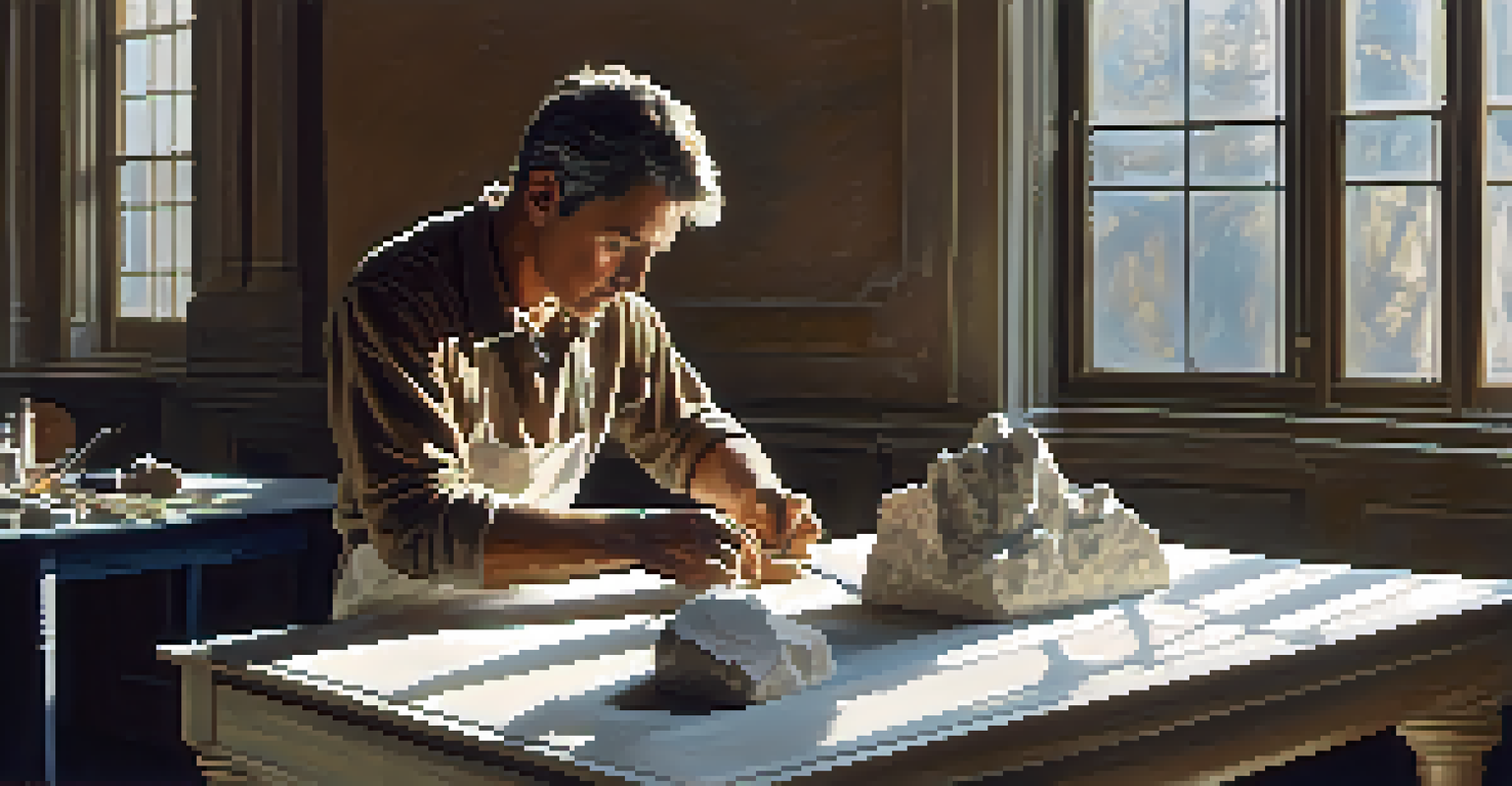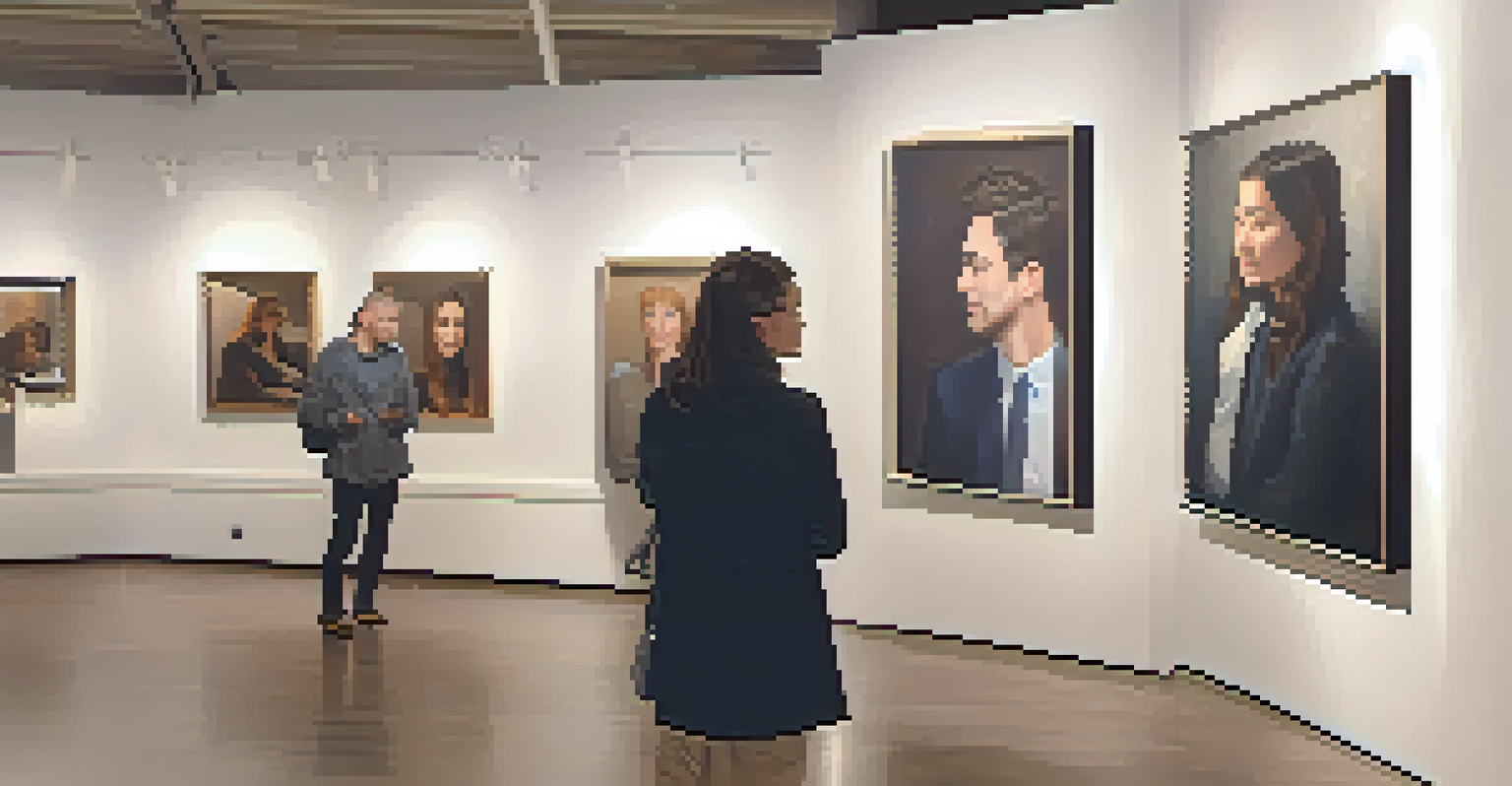The Emotional Journey: How Art Reflects Personal Transformations

Understanding the Connection Between Art and Emotions
Art has always been a powerful medium for expressing and reflecting emotions. Whether it's a painting, a sculpture, or a piece of music, art allows individuals to convey their feelings in ways that words often cannot. This connection between art and emotions opens a window into the artist's soul, revealing personal stories that resonate with viewers on a deeper level.
Art is the most beautiful of all lies.
When we look at a piece of art, we might feel joy, sadness, or nostalgia, and these feelings can trigger memories of our own experiences. This emotional exchange creates a bond between the artwork and the observer, making art a unique form of communication. For instance, a vibrant sunset painting might evoke feelings of hope and new beginnings, while a somber sculpture could invite reflection on loss and healing.
Through this lens, we can see how art serves as a mirror, reflecting our internal landscapes. Each brushstroke, note, or chisel mark carries the weight of emotions, allowing both the creator and the viewer to engage in a transformative dialogue about life’s complexities.
Art as a Tool for Personal Transformation
Many people use art as a means of processing their emotions and navigating personal transformations. Engaging in creative activities can be therapeutic, providing a safe space to explore feelings and experiences. By creating art, individuals often find clarity and understanding, allowing them to confront their emotions head-on.

For example, someone going through a difficult breakup might turn to painting to express their grief. As they pour their feelings onto the canvas, they may uncover insights about their relationship and themselves. This cathartic process not only helps in releasing pent-up emotions but can also lead to personal growth and healing.
Art Expresses Emotions Deeply
Art serves as a powerful medium for individuals to express and reflect their emotions, creating a unique bond between the artwork and the observer.
In this way, art becomes a powerful tool for transformation. It allows individuals to reframe their narratives, helping them to see challenges from a new perspective and ultimately emerge stronger and more self-aware.
The Role of Art in Healing and Recovery
Art has long been recognized for its healing properties, particularly in therapeutic settings. Many art therapists utilize creative expression to help clients navigate their emotions and experiences. Through art, individuals can explore trauma, grief, or anxiety in a non-threatening way, promoting healing and recovery.
Every artist dips his brush in his own soul, and paints his own nature into his pictures.
Consider the example of a person recovering from addiction. Art therapy can provide an outlet for expressing the struggles and triumphs of their journey. Creating art allows them to visualize their progress and articulate feelings that may be too difficult to express verbally, fostering a sense of empowerment and resilience.
By integrating art into the healing process, individuals often experience a greater sense of control over their narratives. It encourages self-reflection and personal insight, making it a vital component of holistic recovery.
Art as a Reflection of Life's Transitions
Life is full of transitions, and art often captures these pivotal moments beautifully. Artists frequently draw inspiration from their own experiences of change, whether it be starting a new job, moving to a different city, or welcoming a child into the world. These transitions can evoke a mix of emotions, and art serves as a way to document and process them.
For instance, a photographer might create a series of portraits depicting the various stages of life, from childhood to old age. Each image tells a story, reflecting not only the physical changes but also the emotional transformations that accompany them. This exploration can resonate with viewers, prompting them to reflect on their own life transitions.
Art Facilitates Personal Growth
Engaging in creative activities allows individuals to process emotions and navigate personal transformations, leading to insights and healing.
Through art, we are reminded that change is a fundamental aspect of the human experience. It encourages us to embrace these transitions, recognizing their role in shaping our identities and guiding our personal journeys.
Cultural Narratives: How Art Reflects Societal Changes
Art is not just a personal endeavor; it also reflects broader societal changes and cultural narratives. Throughout history, artists have responded to political, social, and economic shifts through their work. These pieces often serve as commentary on the human condition, shedding light on collective experiences and emotions.
For example, during times of social upheaval, artists may create powerful works that challenge the status quo or highlight injustices. The murals of the civil rights movement or the music of protest movements illustrate how art can encapsulate the spirit of a time, giving voice to the struggles and aspirations of a community.
By engaging with these cultural narratives, we can better understand our place within society. Art becomes a reflection of our collective journey, inviting us to consider how our personal transformations are intertwined with the larger story of humanity.
The Creative Process: A Journey of Self-Discovery
The act of creating art is itself a journey of self-discovery. As individuals engage with their creativity, they often uncover hidden aspects of themselves. This exploration can reveal passions, fears, and desires that may have been buried beneath the surface, leading to profound personal insights.
For many artists, the creative process is a form of introspection. As they experiment with different mediums and techniques, they may find themselves confronting their inner thoughts and emotions. This can be both liberating and challenging, as it pushes them to face truths they may have avoided.
Art Reflects Cultural Changes
Throughout history, art has captured and commented on societal changes, offering a lens through which we can understand collective experiences and narratives.
Ultimately, this journey of self-discovery through art fosters personal growth. It encourages individuals to embrace their authentic selves and share their stories with the world, paving the way for deeper connections with others.
Sharing Art: Connecting Through Shared Experiences
Sharing art can foster connections between individuals, as it allows for the exchange of experiences and emotions. When artists display their work publicly, they invite others to engage with their stories and perspectives. This shared experience can create a sense of community and understanding, bridging gaps between diverse backgrounds.
For instance, galleries and exhibitions often serve as platforms for artists to connect with audiences. Viewers may find themselves moved by a piece of art, sparking conversations about their own experiences related to the themes presented. This dialogue enriches the emotional journey for both the artist and the observer.

In this way, art becomes a catalyst for connection. It reminds us that while our individual journeys may differ, our emotions and experiences are often universal, creating a shared tapestry of human experience.